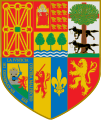Fitxategi:Zazpiak Bat.svg

SVG fitxategi honen PNG aurreikuspenaren tamaina: 504 × 600 pixel. Bestelako bereizmenak: 202 × 240 pixel | 403 × 480 pixel | 645 × 768 pixel | 860 × 1.024 pixel | 1.721 × 2.048 pixel | 579 × 689 pixel.
Bereizmen handikoa (SVG fitxategia, nominaldi 579 × 689 pixel, fitxategiaren tamaina: 1,38 MB)
Fitxategiaren historia
Data/orduan klik egin fitxategiak orduan zuen itxura ikusteko.
| Data/Ordua | Iruditxoa | Neurriak | Erabiltzailea | Iruzkina | |
|---|---|---|---|---|---|
| oraingoa | 22:42, 30 apirila 2009 |  | 579 × 689 (1,38 MB) | SanchoPanzaXXI~commonswiki | retoque lobos |
| 20:31, 30 apirila 2009 |  | 579 × 689 (1,39 MB) | SanchoPanzaXXI~commonswiki | rediseño | |
| 21:52, 28 azaroa 2007 |  | 550 × 650 (384 KB) | SanchoPanzaXXI~commonswiki | {{Information |Description={{en}}Modern version of en:Zazpiak Bat insignia. From the Basque words zazpiak meaning "the seven ones" and bat meaning "one", translates as "the seven ones [are] one", refers to the seven historical Basque Country territor |
Irudira dakarten loturak
Hurrengo orrialdeek dute fitxategi honetarako lotura:
Fitxategiaren erabilera orokorra
Hurrengo beste wikiek fitxategi hau darabilte:
- ar.wikipedia.org proiektuan duen erabilera
- bs.wikipedia.org proiektuan duen erabilera
- ca.wikipedia.org proiektuan duen erabilera
- da.wikipedia.org proiektuan duen erabilera
- en.wikipedia.org proiektuan duen erabilera
- en.wikiversity.org proiektuan duen erabilera
- eo.wikipedia.org proiektuan duen erabilera
- es.wikipedia.org proiektuan duen erabilera
- Euskal Herria
- Escudo de Navarra
- Usuario:Keat
- Usuario:Ultrasiete
- Usuario Discusión:Martiko
- Wikiproyecto:Euskal Herria
- Wikiproyecto Discusión:Euskal Herria
- Wikiproyecto:Euskal Herria/Userbox2
- Usuario:Tximist
- Usuario:Ignaciojd3
- Usuario:Zarateman
- Usuario:Janfri
- Zazpiak Bat
- Usuario:Rikku~eswiki
- Usuario Discusión:Tximist
- Wikiproyecto Discusión:Euskal Herria/Discusiones2
- Portal:Navarra/Portales Relacionados
- Portal:País Vasco
- Portal:País Vasco/Portales relacionados
- Inmigración vasca en Chile
- Usuario:Marine13
- Usuario:El-Numero
- Xabi Aburruzaga
- Usuario:Pablitop
- Usuario:Aberzale
- Usuario:Igalix/Archivo de 2007-2010
- Usuario:Userbox/Localización/España
- Usuaria:Userbox mujer/Localización/España
- Koruko Ama Birjinaren Eskola
- Usuario:Raulsalvatierra1998
- Usuario:Sejuzu
- Jean de Jaurgain
- Armorial de las familias vascas
- Usuario:Gogoter
- fr.wikipedia.org proiektuan duen erabilera
Ikus fitxategi honen erabilpen global gehiago.

